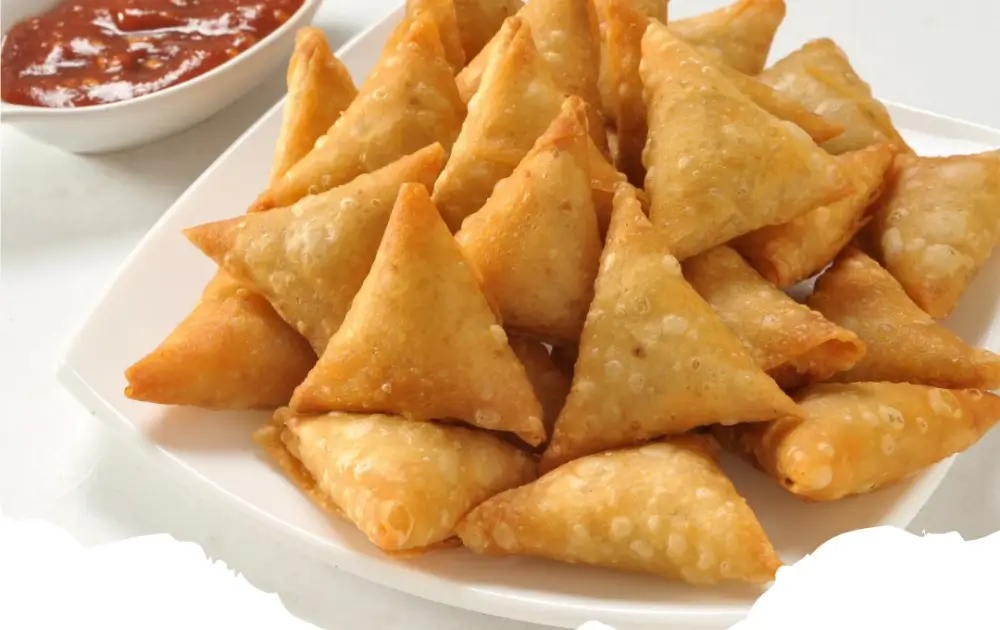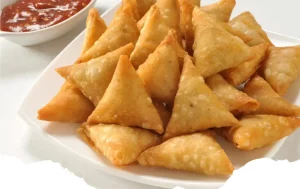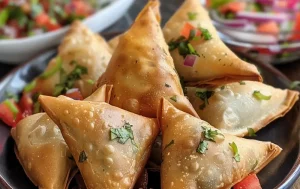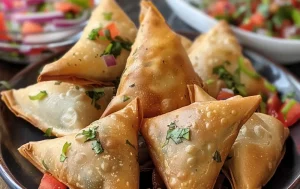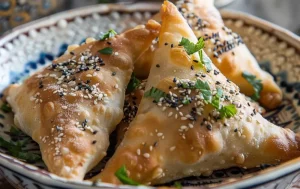A samosa, with its crisp outer layer and richly spiced filling, stands as a beloved snack across various parts of the world. This savory pastry finds its roots in medieval times and has since evolved into a popular delicacy enjoyed in countless variations. Traditionally triangular in shape, a samosa encases a filling of spiced potatoes, peas, lentils, or even meat, making it a versatile dish that caters to a wide range of taste preferences.
Print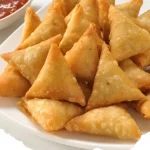
Samosa
- Total Time: 45 minutes
- Yield: Makes 20 samosas 1x
- Diet: Vegetarian
Description
Samosas are a popular snack originating from the Middle East and Central Asia, now a staple in South Asian cuisine. These triangular-shaped pastries are filled with a spicy mixture of potatoes, peas, and sometimes meat, then deep-fried to golden perfection.
Ingredients
For the Dough:
2 cups (250g) Flour
1/4 cup (60ml) Oil or melted ghee
1/4 cup (60ml) Water
1/2 teaspoon Salt
For the Filling:
2 tablespoons Oil
3 Potatoes, boiled (500g)
1 cup (150g) Green peas, fresh or frozen
2 tablespoons Coriander leaves, chopped
1 Green chili, finely chopped
8–10 Cashews, crushed (optional)
2–3 Garlic cloves, crushed
1 tablespoon Ginger paste
1 teaspoon Coriander seeds, crushed
1/2 teaspoon Garam masala
1 teaspoon Chili powder
1 teaspoon Cumin seeds
1 teaspoon Turmeric
1 tablespoon Lemon juice
Salt to taste
1/4 cup (60ml) Water
Instructions
Make the Dough:
In a large mixing bowl, mix flour and salt.
Add the oil and then start mixing with your fingers, rub the flour with the oil until the oil is well incorporated.
Once incorporated, the mixture resembles crumbs.
Start adding water, little by little and mix to form a stiff dough (the dough shouldn’t be soft).
Cover the dough and let it rest for 30 minutes.
Prepare the Filling:
Roughly chop/mash boiled potatoes and set aside.
Heat oil in a large pan, add cumin seeds, coriander seeds, chili powder, turmeric, and garam masala, cook for 30-60 seconds to release the flavors.
Add crushed garlic, ginger paste, chopped green chili and cook for 1 minute.
Add chopped onion and sauté for 3-4 minutes.
Add chopped potatoes, green peas, lemon juice, water, and salt, cook for 4-5 minutes, stirring frequently.
Add crushed cashew and cook for 1 minute more.
Turn off the heat, add chopped coriander leaves, stir well, and set aside to cool.
Shape the Samosas:
Once the dough has rested, give it a quick knead.
Divide the dough into 6-7 equal parts and shape into balls.
Roll out each ball into an oval, about 6-inches long and 4 inches wide.
Cut it into two parts.
Coat the edges of each semicircle with water.
Pick the two corners of the semicircle and bring them together, edges overlapping slightly, to form a cone.
Press down on the seam to stick it.
Fill the samosa with the potato filling, around 1-2 tablespoons. Don’t overfill.
Brush the edges again with water, then pinch the edges and seal the samosa.
Repeat the same process with the remaining dough and filling, keep filled samosas covered with a moist kitchen towel while working.
Fry the Samosas:
Heat oil to 350F (175C).
Drop the samosas into hot oil, 4-5 pieces at a time.
Reduce the heat to medium.
Fry for 4-5 minutes, until golden and crisp.
Serve:
Drain on paper towels before serving.
Serve with your favorite sauce.
Enjoy your delicious homemade samosas!
Notes
- Adjust the spice levels according to preference.
- Samosas can be baked at 375°F for a healthier option, until golden brown.
- Vegetarian (can be adapted for vegan and gluten-free diets).
- Prep Time: 30 minutes
- Cook Time: 15 minutes
- Category: Appetizer/Snack
- Method: Deep frying
- Cuisine: South Asian
Nutrition
- Calories: 150
- Sugar: 1g
- Sodium: 200mg
- Fat: 9g
- Saturated Fat: 1g
- Carbohydrates: 16g
- Fiber: 2g
- Protein: 3g
- Cholesterol: 0mg
FAQs
Can samosas be made with whole wheat flour?
Yes, samosas can be made with whole wheat flour to create a healthier version. Whole wheat flour adds fiber but may result in a slightly denser texture. Adjust the amount of water as needed to ensure the dough remains pliable.
Are there any quick methods for making samosas?
For a quicker version, you can use pre-made pastry sheets or wonton wrappers as a substitute for the traditional dough. These alternatives reduce prep time significantly and are ideal for those seeking convenience without compromising on taste.
Can samosas be frozen?
Absolutely, samosas freeze well. Cook them partially if frying, or fully bake if that’s your method, then cool and freeze on a tray before transferring to a freezer-safe bag. Reheat in an oven or air fryer for best results.
What are the best dipping sauces for samosas?
Mint chutney, tamarind sauce, and yogurt-based dips are classic accompaniments for samosas. Experimenting with spicy ketchup, sweet chili sauce, or herb-infused yogurts can also offer delightful flavor combinations.
Are samosas vegan or vegetarian?
Samosas can be both vegan and vegetarian, depending on the filling. Traditional potato and pea fillings are naturally vegan, while meat-filled samosas cater to non-vegetarian preferences. Ensure the dough and cooking methods align with dietary needs.
The History of Samosas
The samosa’s journey began in the Middle East before the 10th century and made its way to the Indian subcontinent with traders and travelers. Initially served as a delicacy in the royal courts, samosas gradually became a staple among the general populace, thanks to their delicious taste and the convenience of being a handheld snack. Over time, regional variations developed, each adding a unique twist to the classic recipe.
Ingredients and Variations
The basic ingredients for a traditional samosa include a dough made from flour and water, and a filling that commonly features mashed potatoes, peas, spices, and herbs. Variations might incorporate minced meat, cheese, or even sweet fillings for a dessert version. Spices such as cumin, coriander, and garam masala are key to achieving the signature flavor that samosas are known for.
Preparation and Cooking Techniques
Preparing samosas involves making the dough, preparing the filling, and then assembling the pastries by stuffing the dough with the filling before sealing them into triangles. The cooking process typically involves deep-frying, resulting in a golden, crispy exterior. However, healthier versions may be baked or air-fried, offering a lighter alternative without compromising on taste.
Serving and Enjoyment
Samosas are commonly served with chutneys or sauces, such as tamarind or mint chutney, adding an extra layer of flavor. They make an excellent appetizer or snack and are a popular choice at gatherings and celebrations. The versatility of samosas allows them to be a satisfying treat at any time of day, pairing wonderfully with a cup of tea or as part of a larger meal.
Cultural Significance and Global Appeal
The samosa has transcended its origins to become a global sensation, reflecting the diverse culinary practices and preferences of different regions. Its ability to adapt to local tastes while maintaining its essential characteristics is a testament to its universal appeal. Today, samosas are celebrated not just as a food item but as a cultural icon, bringing people together over a shared love for this delightful pastry.
Innovative Twists on the Classic Samosa
Chefs and home cooks alike have begun experimenting with the classic samosa, introducing innovative twists that cater to modern palates. Fusion samosas, which blend ingredients from various cuisines, such as Mexican-style fillings with beans and cheese or Italian-influenced versions with mozzarella and tomato, showcase the versatility of this dish. Sweet versions filled with chocolate or fruit preserves offer a delightful dessert alternative, proving that the possibilities with samosas are endless.
Nutritional Considerations
While traditional samosas, deep-fried and filled with potatoes, can be calorie-dense, there are numerous ways to make them healthier. Using whole wheat flour for the dough, opting for baking or air-frying, and incorporating a filling rich in vegetables or lean protein can transform samosas into a nutritious snack. These modifications make samosas more accessible to health-conscious individuals, allowing everyone to enjoy them without guilt.
Samosa Making as a Social Activity
The process of making samosas often becomes a social activity, bringing friends and family together in the kitchen. The act of stuffing and folding the dough is not only therapeutic but also provides an opportunity for bonding. Many cultures have embraced samosa making as a communal event, especially during festivals and special occasions, highlighting its role in fostering community and togetherness.
Global Samosa Celebrations
Samosas have garnered such widespread popularity that they are celebrated in various parts of the world beyond their cultural origins. Food festivals often feature samosa competitions, cooking workshops, and stalls dedicated to this beloved snack, attracting enthusiasts eager to explore its diverse flavors and forms. This global recognition underscores the samosa’s enduring appeal and its ability to unite people across different backgrounds through the universal language of food.
The Art of Perfecting Samosa Pastry
Achieving the perfect samosa pastry is crucial for the ideal balance of crunch and flavor. Expert cooks advise using cold water to bind the dough and resting it before rolling it out. This ensures that the pastry is elastic yet firm enough to hold the filling without tearing. The thickness of the pastry is another key factor; it should be thin enough to crisp up during frying but sturdy enough to contain the filling securely. Mastering the pastry is a skill that many aspire to, making the process of creating samosas as rewarding as enjoying them.
Embracing Regional Samosa Recipes
Across the globe, regional variations of the samosa reflect the culinary heritage and preferences of local cultures. In East Africa, samosas filled with spiced minced meat and peas are a staple at social gatherings. In the Middle East, samboosas boast thinner pastry shells and often include a mixture of cheese, meat, or spinach. These regional recipes encourage culinary exploration and offer a taste of the local flavor, making the samosa a truly international delicacy.
The Environmental Impact of Samosa Production
As with any food production, making samosas has an environmental impact, particularly in terms of packaging and oil usage for frying. Conscious efforts to minimize waste and promote sustainable cooking methods are increasingly important. Using reusable packaging and recycling cooking oil are steps toward reducing the environmental footprint of samosa production, making it more eco-friendly.
Samosas in the Digital Age
The digital age has transformed how recipes are shared and discovered, and samosas are no exception. Online cooking tutorials, food blogs, and social media platforms are rich sources of samosa recipes, offering a plethora of variations and cooking tips. This digital culinary exchange makes it easier for food enthusiasts to experiment with making samosas at home, fostering a global community of samosa lovers.
Pairing Samosas with Beverages
To enhance the samosa eating experience, pairing it with the right beverage is key. Traditional Indian chai, with its aromatic spices, complements the flavors of a spicy samosa perfectly. For a refreshing contrast, cool lassi or a crisp beer can balance the richness of the pastry. Experimenting with beverage pairings can elevate the humble samosa to a gourmet level, offering a complete sensory experience.
Future Trends in Samosa Cuisine
Looking ahead, the evolution of the samosa is bound to continue, with chefs and home cooks alike pushing the boundaries of traditional recipes. Incorporating plant-based fillings, experimenting with gluten-free doughs, and exploring sustainable cooking methods are just a few trends shaping the future of samosa cuisine. As global culinary traditions become increasingly interconnected, the samosa’s journey from a simple street food to a gourmet delight showcases the dynamic nature of food and its ability to adapt and thrive in a changing world.
Leveraging Technology for Samosa Innovation
With advancements in food technology, the samosa is entering a new era of innovation. Automated cooking machines and precision baking tools are making samosa production more efficient and consistent, allowing for even more experimentation with fillings and shapes. Food scientists and chefs collaborate to create gluten-free and low-carb doughs, ensuring that the samosa remains relevant in a health-conscious society. This technological evolution not only improves the quality of samosas but also expands their reach to a wider audience.
Educational Workshops and Samosa Masterclasses
Culinary schools and community centers now offer workshops and masterclasses dedicated to the art of making samosas. These educational sessions cover a range of skills, from basic dough preparation to advanced folding techniques and creative filling ideas. Participants gain hands-on experience, learning from seasoned chefs who share their secrets to crafting the perfect samosa. These workshops not only preserve the culinary tradition but also inspire a new generation of samosa enthusiasts.
Samosa as a Canvas for Culinary Artistry
The samosa has become a canvas for culinary artistry, where chefs express their creativity and cultural heritage. Gourmet versions featuring exotic ingredients like truffles, gourmet cheeses, and premium meats highlight the luxury side of samosa cuisine. Food artists use colorful doughs and intricate folding patterns to create visually stunning samosas, making them not just a treat for the palate but also a feast for the eyes. This artistic approach transforms the samosa from a humble snack into a piece of edible art.
Community and Charity Initiatives Involving Samosas
Samosas serve as more than just a delicious snack; they’re also a vehicle for community engagement and charity. Many organizations host samosa sales as fundraisers, supporting local causes and international aid efforts. These events bring communities together, showcasing the power of food to unite people for a common good. By participating in or organizing a samosa-based charity event, individuals contribute to a larger social impact while sharing their love for this iconic dish.
The Role of Samosas in Cultural Exchange Programs
Cultural exchange programs increasingly include culinary components, recognizing the role of food in bridging cultural divides. Samosas, with their rich history and widespread popularity, often feature in these programs as representatives of South Asian cuisine. Participants learn to prepare samosas, delving into the history and traditions behind them, fostering a deeper appreciation for the cultures they originate from. This culinary exchange enriches the experience, offering a taste of home to some and introducing new flavors to others, embodying the spirit of cultural exchange through food.

